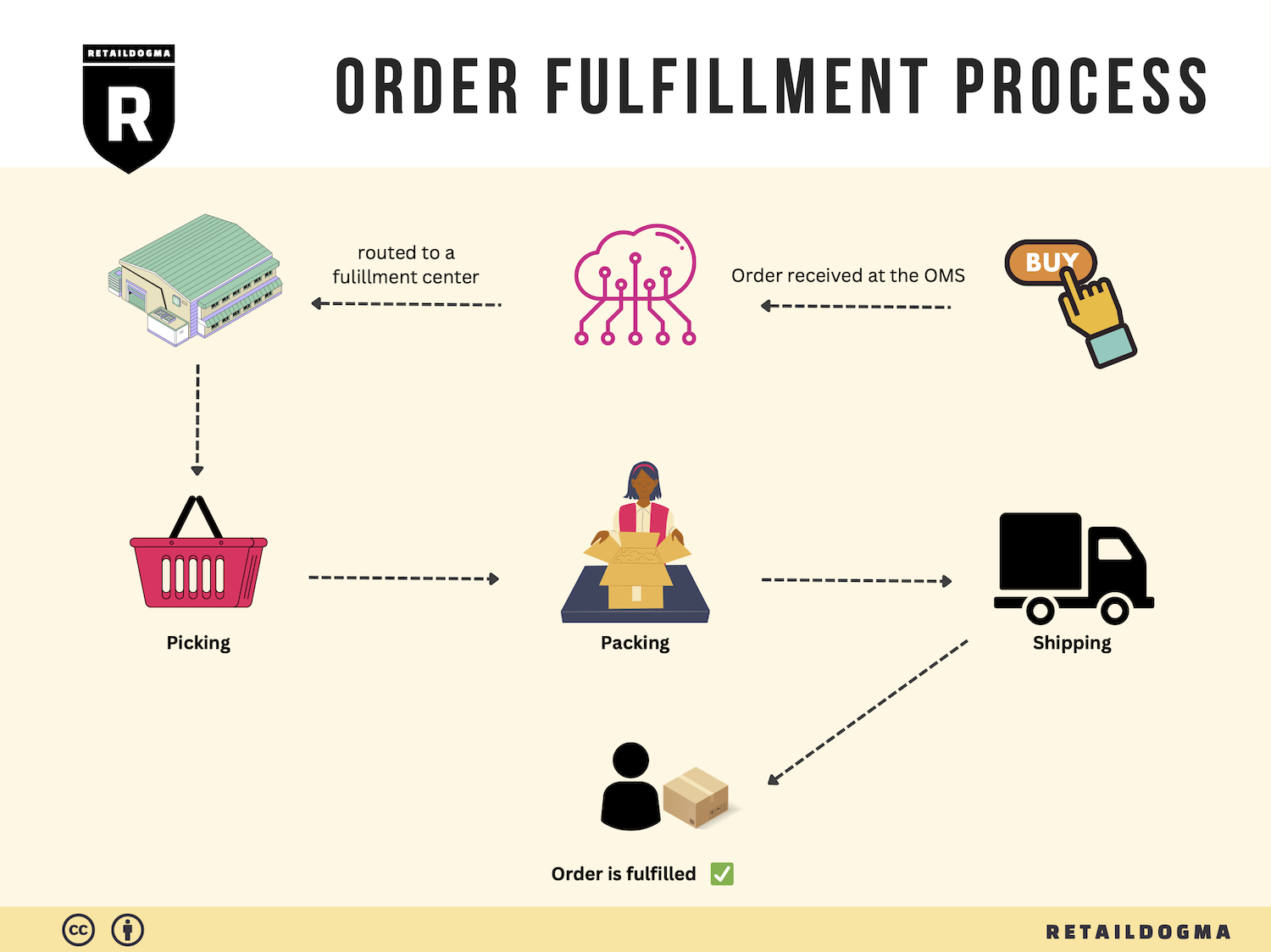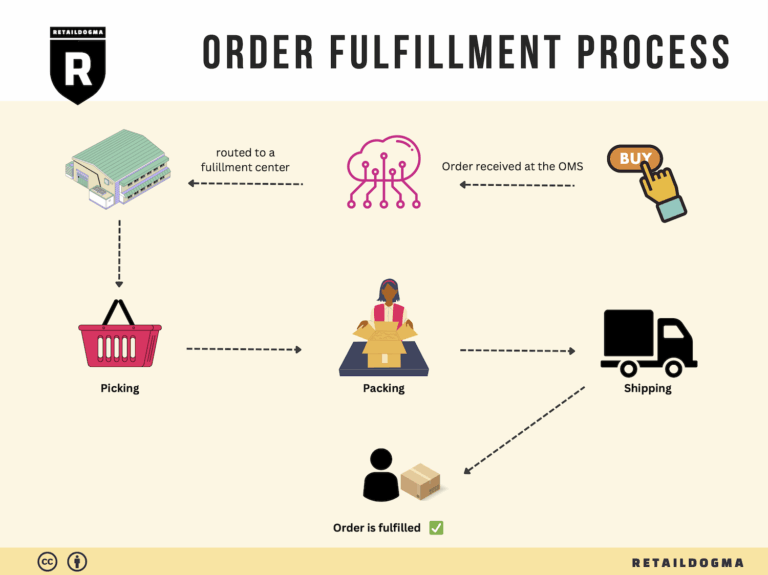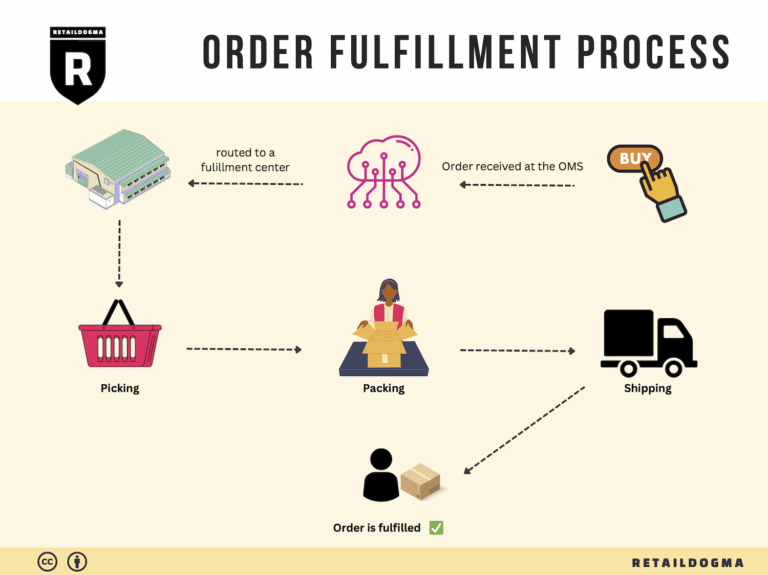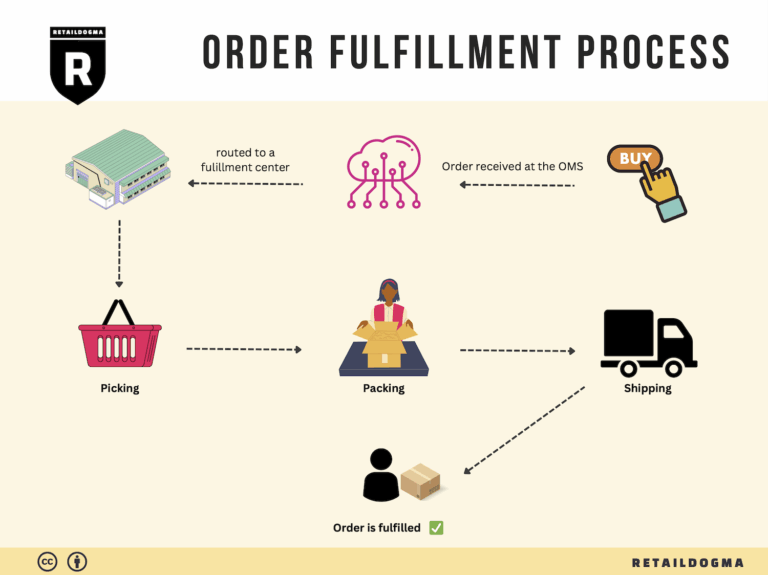What Is A Fulfillment Center? A Complete Guide (2025)
What is E-commerce Fulfillment? An Introduction for Growing Businesses
Understanding the Challenge of Order Fulfillment
As an e-commerce business owner, you may find yourself grappling with a common pain point: the overwhelming task of packing and shipping orders. The excitement of growing sales can quickly turn into stress as you juggle inventory management, order processing, and customer service, all while striving to meet delivery expectations. This is where e-commerce fulfillment comes into play.
Fulfillment is simply the process of getting a product from your warehouse (or a partner’s facility) to your customer’s doorstep. It encompasses various stages, including receiving inventory, storing products, picking and packing orders, and finally shipping them out. As your business scales, the complexity of these tasks can increase significantly, making it crucial to understand your options and streamline operations effectively.
What This Guide Will Cover
In this comprehensive guide, we will explore the different fulfillment models available to growing e-commerce businesses, including Third-Party Logistics (3PL) and Fulfillment by Amazon (FBA). Understanding these models will help you determine which approach aligns best with your business needs and customer expectations.
We will delve into the core services offered by fulfillment partners, such as inventory management, order processing, shipping logistics, and returns handling. Knowing what services are available can empower you to select a partner that not only alleviates your workload but also enhances your customer experience.
Choosing the right fulfillment partner is a critical decision that can impact your operations and profitability. We will provide practical criteria for evaluating potential partners, including their technology capabilities, service levels, and scalability options. Additionally, we will discuss pricing structures and how to assess the total cost of fulfillment services, enabling you to make informed financial decisions.
Empowering Your Business Decisions
The goal of this guide is to empower you with the knowledge needed to make smart decisions about your logistics strategy. By understanding the intricacies of e-commerce fulfillment and the options available, you can focus on what you do best—growing your business and delighting your customers. Whether you’re considering outsourcing fulfillment for the first time or looking to optimize your existing processes, this guide will provide you with actionable insights to navigate the complexities of e-commerce fulfillment confidently.
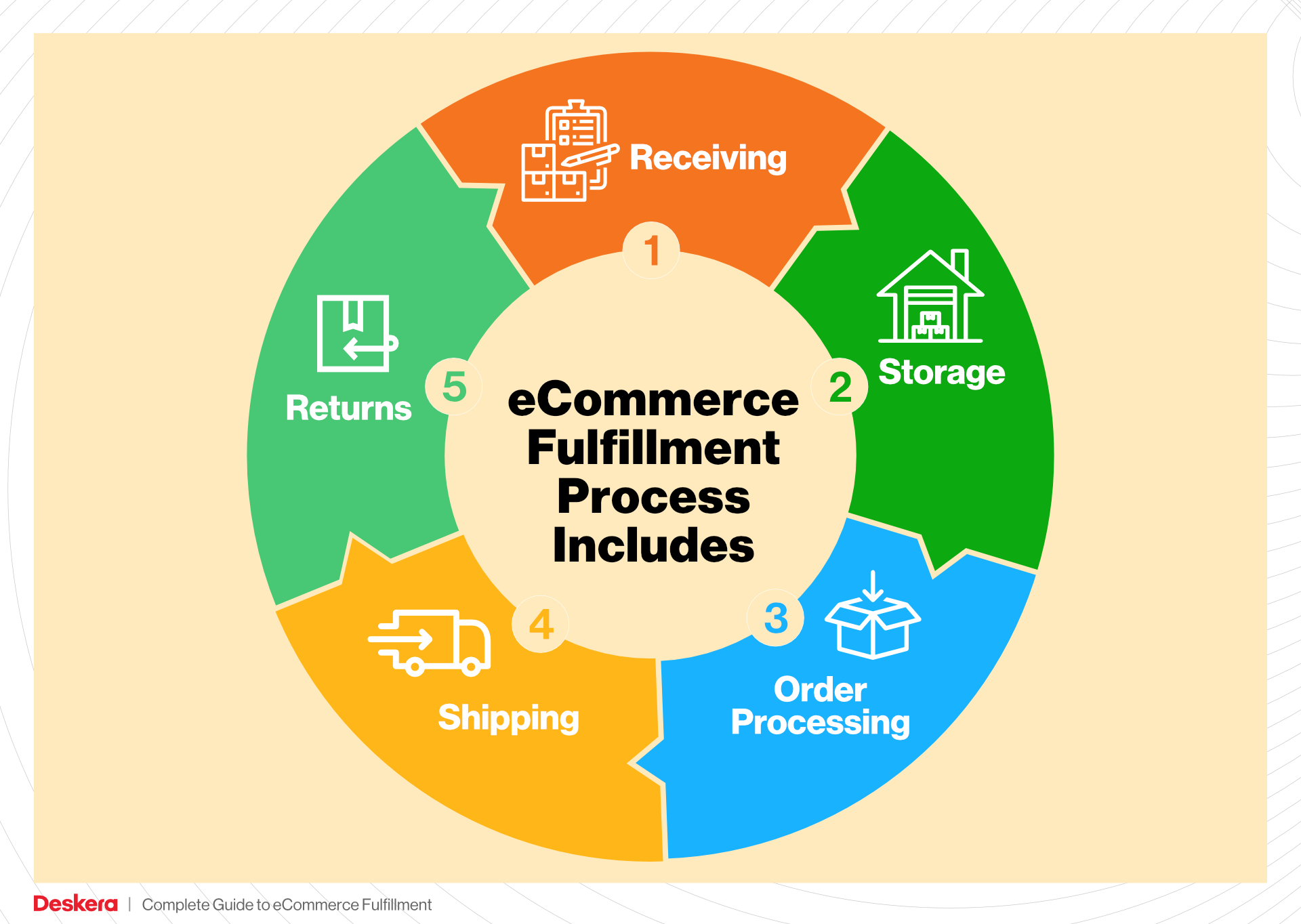
What You’ll Learn In This Guide
- What is E-commerce Fulfillment? An Introduction for Growing Businesses
- The Order Fulfillment Process: From ‘Buy’ Button to Customer’s Door
- Comparing Fulfillment Models: In-House vs. 3PL vs. Dropshipping
- A Deep Dive into Amazon FBA: Pros, Cons, and Who It’s For
- Core Services Offered by Fulfillment Centers
- How to Choose a Fulfillment Partner: A 6-Point Checklist
- Understanding Fulfillment Pricing: A Breakdown of Common Fees
- Frequently Asked Questions (FAQs) about Fulfillment
- Conclusion: Is Outsourcing Fulfillment the Right Move for Your Business?
- Important Disclaimer
The Order Fulfillment Process: From ‘Buy’ Button to Customer’s Door
1. Receiving Inventory
The order fulfillment process begins with receiving inventory at the fulfillment center. This step involves the careful acceptance of products from suppliers or manufacturers. Each shipment is checked against purchase orders to ensure accuracy in quantities and product types. A key term associated with this step is SKU (Stock Keeping Unit), which is a unique identifier for each product that helps track inventory levels.
Receiving inventory is crucial for maintaining an accurate inventory count and preventing stock discrepancies. Proper receiving processes ensure that products are in good condition and match the expected specifications. Effective inventory management starts here; any errors at this stage can lead to complications later in the fulfillment process, including stockouts or overstocks, which can negatively impact customer satisfaction.
2. Warehouse Storage
Once inventory is received, it is stored in the fulfillment center. This involves organizing products in a way that maximizes space and ensures efficient retrieval. Fulfillment centers typically use a warehouse management system (WMS) to track inventory locations, manage stock levels, and monitor product movements.
Proper warehouse storage is vital for efficient operations. When products are stored correctly, it reduces the time spent locating items during the order picking phase. A well-organized storage system not only enhances the speed of operations but also minimizes the risk of errors, ensuring that the right products are picked for customer orders. Additionally, effective storage solutions can help optimize space, allowing businesses to scale operations without the need for additional warehouse space.
3. Order Picking
The next step in the fulfillment process is order picking, where items are selected from their storage locations based on incoming customer orders. This process often utilizes pick lists, which are documents that specify the products and quantities needed for each order. Advanced fulfillment centers may employ automated systems or robotics to aid in this process.
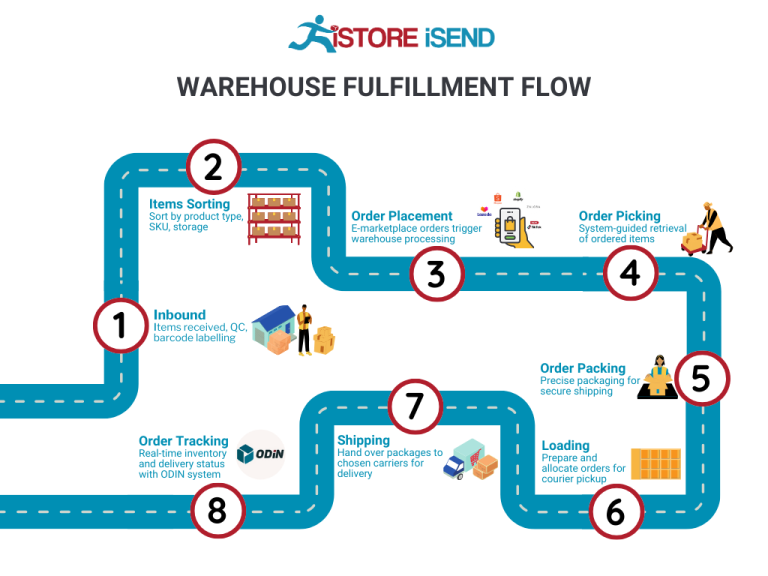
Order picking is a critical component of fulfilling customer expectations. Speed and accuracy during this stage directly influence delivery times and customer satisfaction. Errors in picking can lead to incorrect orders, resulting in returns and lost customer trust. Therefore, businesses must focus on streamlining this process, whether through technology, training, or optimizing layout to facilitate quicker access to frequently ordered items.
4. Order Packing
After items are picked, they move on to the order packing stage. Here, products are carefully packaged for shipment to ensure they arrive at the customer’s door in perfect condition. This step often involves using materials like boxes, bubble wrap, and packing peanuts to protect items during transit. A key term related to this phase is kitting, which refers to bundling multiple items together into a single package for shipment.
Packing is essential not only for protecting products but also for creating a positive unboxing experience for customers. Effective packing processes help reduce shipping costs by optimizing package sizes and weights. Additionally, branding opportunities during packing—such as custom packaging or including promotional materials—can enhance customer loyalty and encourage repeat purchases.
5. Shipping & Delivery
The final step in the order fulfillment process is shipping and delivery. Once an order is packed, it is labeled and handed over to a carrier for transportation to the customer. This stage involves selecting the most efficient shipping method, which can be influenced by factors such as delivery speed, cost, and destination. Key terms associated with this step include last-mile delivery, which refers to the final leg of the shipment journey from the distribution center to the customer’s doorstep.
Shipping and delivery are critical for customer satisfaction. Timely and accurate deliveries can significantly enhance the customer experience, while delays or issues can lead to dissatisfaction and negative reviews. Businesses must work closely with shipping partners to ensure that delivery expectations are met and to provide tracking information to customers. This transparency fosters trust and improves the overall shopping experience.
In conclusion, understanding and optimizing each step of the order fulfillment process is essential for e-commerce businesses looking to scale. By focusing on efficient inventory management, storage solutions, picking accuracy, effective packing, and reliable shipping, businesses can enhance customer satisfaction and drive growth in their operations.

Comparing Fulfillment Models: In-House vs. 3PL vs. Dropshipping
Fulfillment Model Comparison
| Model | Who Handles Inventory | Best For (Business Stage) | Key Advantage | Key Disadvantage |
|---|---|---|---|---|
| In-House Fulfillment | The e-commerce business itself | Startups to established brands | Full control over inventory and processes | High overhead and operational complexity |
| Third-Party Logistics (3PL) | Third-party fulfillment company | Growing businesses | Scalable solutions and expertise | Potential loss of control and higher costs |
| Dropshipping | Supplier or manufacturer | Startups and small businesses | Low upfront investment and risk | Lower margins and reliance on suppliers |
In-House Fulfillment
In-house fulfillment involves managing the entire logistics process within the e-commerce business itself. This model is typically adopted by startups and established brands that want to maintain complete control over their inventory and fulfillment processes. The business is responsible for everything from warehousing, inventory management, order picking, packing, and shipping.
One of the key advantages of in-house fulfillment is the ability to directly oversee operations, ensuring quality control and a personalized customer experience. Businesses can tailor their processes, packaging, and shipping methods to align with their brand values. However, this model also comes with significant challenges. The overhead costs can be substantial, as businesses need to invest in warehousing, staff, and technology. Additionally, managing the complexities of logistics can divert focus away from core business activities like product development and marketing, potentially stunting growth.
Third-Party Logistics (3PL)
Third-party logistics (3PL) companies provide a comprehensive suite of logistics services, allowing e-commerce businesses to outsource their fulfillment operations. This model is ideal for growing businesses that require flexible and scalable solutions without the burden of managing logistics in-house. 3PL providers handle inventory storage, order processing, shipping, and returns management, often integrating seamlessly with e-commerce platforms.
The primary advantage of utilizing 3PL services is the access to expertise and advanced logistics technology without the associated overhead costs of running an in-house operation. Businesses can focus on their core competencies while benefiting from the efficiencies that 3PLs offer, such as faster shipping times and reduced shipping costs through established carrier relationships. However, one of the downsides is the potential loss of control over the fulfillment process. Businesses must rely on their 3PL partners to meet customer expectations, and any lapses in service can directly affect customer satisfaction and brand reputation. Additionally, the costs associated with 3PL services can vary based on order volume and specific services required, which may impact profit margins.
Dropshipping
Dropshipping is a fulfillment model where the e-commerce business sells products without holding inventory. Instead, the business partners with suppliers or manufacturers who handle inventory and shipping directly to the customer. This model is particularly well-suited for startups and small businesses looking to enter the market with minimal upfront investment and risk.
The key advantage of dropshipping is the low barrier to entry; businesses do not need to invest in inventory upfront, which significantly reduces financial risk. This model allows entrepreneurs to test new products and markets without the burden of excess inventory. However, dropshipping also comes with notable disadvantages. Profit margins tend to be lower since suppliers set prices, and businesses have less control over product quality, shipping times, and customer service. Moreover, reliance on suppliers can lead to stock issues or delays, potentially resulting in dissatisfied customers. As a business scales, managing relationships with multiple suppliers can become complex and time-consuming.
Conclusion
Choosing the right fulfillment model is crucial for e-commerce businesses, as it directly impacts operational efficiency, customer satisfaction, and overall profitability. In-house fulfillment provides complete control but requires significant investment and operational complexity. On the other hand, 3PL offers scalability and expertise, allowing businesses to focus on growth, albeit with potential trade-offs in control and cost. Lastly, dropshipping presents a low-risk entry point into the market but may compromise profit margins and control over customer experience. Each model has its merits and challenges, and the choice should align with the business’s current stage, resources, and long-term objectives.
A Deep Dive into Amazon FBA: Pros, Cons, and Who It’s For
What is Fulfillment by Amazon (FBA)?
Fulfillment by Amazon (FBA) is a service offered by Amazon that allows sellers to store their products in Amazon’s fulfillment centers. Amazon takes care of the storage, packaging, and shipping of these products directly to customers. By leveraging Amazon’s extensive logistics network, sellers can focus on other aspects of their business, such as marketing and product development, while Amazon handles the complexities of order fulfillment.
When a customer makes a purchase, Amazon picks, packs, and ships the product on behalf of the seller. Additionally, FBA provides customer service and handles returns, allowing sellers to maintain a high level of customer satisfaction. The integration of FBA into an e-commerce strategy can significantly impact a seller’s reach, especially with Amazon’s vast customer base and trusted reputation.
How FBA Works
-
Account Setup: Sellers must create an Amazon Seller account and enroll in the FBA program. This process includes agreeing to the terms and conditions specific to FBA.
-
Product Listing: Sellers create product listings on Amazon, indicating that they will use FBA. This involves providing product details, pricing, and inventory levels.
-
Inventory Shipment: Sellers then send their inventory to Amazon’s fulfillment centers. Amazon provides specific guidelines regarding packaging and labeling to ensure that products are ready for storage and shipping.
-
Storage and Management: Once the inventory arrives at the fulfillment center, Amazon takes over. They manage the storage, ensuring that products are organized and easily accessible for order fulfillment.
-
Order Fulfillment: When a customer places an order, Amazon picks the item from the inventory, packs it, and ships it directly to the customer. FBA orders are eligible for Amazon Prime and other Amazon services, enhancing the attractiveness of products.
-
Customer Support: Amazon handles all customer service inquiries and returns for FBA products, allowing sellers to provide a seamless customer experience without the logistical burden.
Pros of Fulfillment by Amazon (FBA)
-
Prime Eligibility: One of the most significant advantages of FBA is that products become eligible for Amazon Prime. This not only enhances visibility but also attracts Prime members who prefer fast, free shipping.
-
Customer Trust: Amazon is a trusted brand, and customers often prefer buying products fulfilled by Amazon. This trust can lead to higher conversion rates as customers feel more secure purchasing from a seller who utilizes FBA.
-
Multi-Channel Fulfillment: FBA isn’t limited to Amazon alone. Sellers can use FBA to fulfill orders from their own websites or other marketplaces, allowing for a streamlined logistics operation across multiple sales channels.
-
Simplified Logistics: By outsourcing fulfillment to Amazon, sellers can save time and resources. They no longer need to manage warehousing, packing, or shipping, allowing them to focus on growing their business.
-
Scalability: FBA allows sellers to scale their operations easily. As demand increases, sellers can send more inventory to Amazon without needing to invest in additional warehousing or logistics infrastructure.
Cons of Fulfillment by Amazon (FBA)
-
High Fees: While FBA provides many benefits, it comes at a cost. Sellers must pay various fees, including storage fees for inventory in Amazon’s warehouses and fulfillment fees for each order processed. These costs can add up, especially for sellers with lower margins.
-
Strict Inventory Rules: Amazon has strict guidelines regarding inventory management, including storage limits and performance metrics. Failure to adhere to these rules can result in additional fees or suspension of selling privileges.
-
Commingling Risks: One potential risk of using FBA is the commingling of inventory. Amazon may mix a seller’s products with those of other sellers, which can lead to issues with product returns or quality control if a customer receives a product from another seller instead of the original.
-
Limited Control: Sellers have less control over the fulfillment process. Amazon dictates the shipping methods and processes, which may not align with a seller’s brand standards or customer expectations.
-
Dependency on Amazon: Relying heavily on FBA can create a dependency on Amazon’s platform. Changes in Amazon’s policies, fees, or algorithms can significantly impact a seller’s business, leaving them vulnerable to market fluctuations.
Who is FBA Best For?
Fulfillment by Amazon is particularly beneficial for:
-
Small to Medium-Sized Businesses: Sellers who may not have the resources to manage their own logistics operations can greatly benefit from FBA, allowing them to compete with larger retailers.
-
Sellers with High Sales Volume: Those who experience high order volumes can leverage FBA to manage logistics efficiently without the need for significant investment in warehousing.
-
E-commerce Entrepreneurs: Individuals looking to start or grow their online business can use FBA to quickly establish a presence on Amazon and reach a broad customer base without the complexities of fulfillment.
-
Brands Seeking Prime Customers: Businesses wanting to tap into the lucrative Amazon Prime market can use FBA to make their products eligible for Prime shipping, enhancing visibility and sales potential.
-
Multi-Channel Sellers: Sellers who operate across various platforms can use FBA to streamline their fulfillment processes, providing consistent service across different sales channels.
In conclusion, Fulfillment by Amazon offers e-commerce sellers a powerful tool for scaling their business through efficient logistics and enhanced customer reach. However, it’s essential to weigh the pros and cons carefully to determine if it aligns with your business goals and operational capabilities.
Core Services Offered by Fulfillment Centers
Inventory Management & Warehousing
Inventory management and warehousing are foundational services provided by fulfillment centers that significantly impact an e-commerce business’s operational efficiency. This service involves the systematic tracking and control of inventory levels, ensuring that products are available for order fulfillment while minimizing excess stock.
Fulfillment centers utilize advanced software systems to monitor inventory in real-time, providing businesses with valuable insights into stock levels, turnover rates, and demand forecasting. This capability allows e-commerce owners to make informed decisions regarding restocking and product launches, ultimately optimizing their inventory turnover and reducing holding costs.
The benefits of effective inventory management and warehousing are manifold. Firstly, it enhances order accuracy, as businesses can ensure they have the correct items in stock when orders are placed. Secondly, it reduces the risk of stockouts, which can lead to lost sales and dissatisfied customers. Lastly, streamlined inventory processes allow businesses to focus on scaling their operations rather than getting bogged down in logistics.
Pick and Pack Services
Pick and pack services are critical components of the fulfillment process, directly influencing the speed and accuracy of order delivery. This service entails the selection (picking) of products from the warehouse based on customer orders, followed by packing these items for shipment.
Fulfillment centers employ efficient picking methods, such as batch picking or zone picking, to optimize the speed at which orders are processed. Once the items are selected, they are packed using appropriate materials to ensure safe transit. This process not only involves placing items in boxes but also includes labeling, documentation, and sometimes adding promotional materials or personalized notes for customers.
The benefits of pick and pack services are substantial. They significantly reduce the time from order placement to delivery, enhancing customer satisfaction. Furthermore, the accuracy of the picking process minimizes errors, leading to fewer returns and exchanges. In a world where consumers expect fast and reliable service, having a robust pick and pack operation can set an e-commerce business apart from its competitors.
Kitting and Assembly
Kitting and assembly services offered by fulfillment centers allow e-commerce businesses to streamline their product offerings and create bundled products that appeal to customers. Kitting involves grouping individual items together to form a single product package, while assembly refers to the process of putting together multiple components to create a finished product.
This service is particularly beneficial for businesses looking to enhance their product range without increasing complexity in inventory management. By utilizing kitting, e-commerce businesses can offer special promotions, gift sets, or subscription boxes that drive sales and increase customer engagement. Assembly services are invaluable for companies selling products that require setup or combination, such as furniture or electronics.
The advantages of kitting and assembly are twofold. Firstly, they can lead to increased average order value (AOV) by encouraging customers to purchase bundled items. Secondly, kitting reduces the time spent on order fulfillment, as pre-packaged items can be shipped directly to customers without additional handling. This efficiency can translate into lower shipping costs and faster delivery times, ultimately enhancing the customer experience.
Returns Management (Reverse Logistics)
Returns management, often referred to as reverse logistics, is a crucial service that addresses the complexities of product returns in e-commerce. This service encompasses the processes involved in handling returned products, including inspection, restocking, and processing refunds or exchanges.
Fulfillment centers provide a systematic approach to returns management, allowing businesses to efficiently handle returns while minimizing the impact on their bottom line. They utilize technology to track return reasons, manage inventory adjustments, and analyze trends, which can provide insights into product quality and customer satisfaction.
The benefits of effective returns management are significant. A well-handled returns process can enhance customer loyalty, as consumers are more likely to shop with businesses that offer hassle-free returns. Additionally, it can reduce operational costs associated with processing returns by streamlining the workflow and minimizing the time items spend out of inventory. In an era where customer experience is paramount, having a robust returns management system is essential for maintaining a competitive edge.
In summary, fulfillment centers provide essential services that support the growth and efficiency of e-commerce businesses. From effective inventory management and warehousing to streamlined pick and pack services, kitting and assembly, and efficient returns management, these core services enable businesses to focus on strategic growth while ensuring customer satisfaction. By leveraging these services, e-commerce owners can enhance their operational capabilities, reduce costs, and ultimately drive sales.
How to Choose a Fulfillment Partner: A 6-Point Checklist
Location & Warehouse Network
Importance:
The geographic location of a fulfillment partner’s warehouses can significantly impact shipping costs and delivery times. A partner with strategically located warehouses can help you reach your customers faster and more economically, enhancing customer satisfaction and loyalty.
Questions to Ask:
– Where are your fulfillment centers located?
– How do you determine the best warehouse for shipping to my customers?
– What is your average shipping time to major regions?
– Do you have plans to expand your warehouse network in the near future?
Technology & Integrations
Importance:
In today’s digital landscape, seamless technology integration is crucial for efficient operations. Your fulfillment partner should have robust software that can easily integrate with your e-commerce platform, inventory management system, and other necessary tools. This ensures real-time visibility into inventory levels, order status, and shipping information, allowing for better decision-making.
Questions to Ask:
– What technology do you use for inventory management and order processing?
– Can your system integrate with my existing e-commerce platform (e.g., Shopify, WooCommerce)?
– How do you handle inventory tracking and reporting?
– Are there any additional costs for integrations or using your software?
Specializations (e.g., Cold Storage, Oversized Items)
Importance:
Depending on your product type, you may need a fulfillment partner with specific capabilities. For example, if you sell perishable goods, a partner with cold storage facilities is essential. Similarly, if your products are large or heavy, ensure the partner has the expertise and equipment to handle these items efficiently.
Questions to Ask:
– Do you offer specialized storage options (e.g., cold storage, hazardous materials)?
– What experience do you have in handling my specific type of products?
– How do you manage inventory for specialized items?
– Can you provide examples of clients in similar industries?
Scalability & Capacity
Importance:
As your business grows, so will your logistics needs. Choosing a fulfillment partner that can scale with you is vital to accommodate increased order volumes without sacrificing service quality. A partner with flexible capacity can help you navigate seasonal spikes and unexpected growth.
Questions to Ask:
– How do you handle fluctuations in order volume, such as seasonal spikes?
– What is your current capacity for storage and order fulfillment?
– Can you accommodate my business growth over the next few years?
– What are your plans for scaling operations in the future?
Pricing and Contracts
Importance:
Understanding the cost structure is crucial for maintaining profitability. Different fulfillment partners may have varying pricing models based on storage, order processing, shipping, and additional services. Being clear on costs upfront can prevent unexpected fees and ensure you choose a partner that aligns with your budget.
Questions to Ask:
– Can you provide a detailed breakdown of your pricing structure?
– Are there any hidden fees (e.g., for storage, packaging, returns)?
– What is your pricing model (e.g., per order, monthly fees)?
– How flexible are your contract terms, and what is the notice period for cancellation?
Customer Support & Reviews
Importance:
Effective customer support can make a significant difference in your partnership. You want a fulfillment partner that is responsive and proactive in addressing issues as they arise. Additionally, researching reviews and testimonials can provide insights into the partner’s reliability and service quality.
Questions to Ask:
– What support channels do you offer (e.g., phone, email, chat)?
– What is your average response time to support inquiries?
– Can you provide references from current or past clients?
– How do you handle issues such as lost packages or shipping delays?
Conclusion
Choosing the right fulfillment partner is a critical decision that can impact your e-commerce business’s efficiency and growth. By carefully evaluating potential partners against this checklist, you can ensure that you select a fulfillment service that aligns with your operational needs and strategic goals. Take the time to ask the right questions, assess their capabilities, and consider their track record to make an informed decision that will support your business’s success.
Understanding Fulfillment Pricing: A Breakdown of Common Fees
Initial Setup Fees
When engaging a third-party logistics (3PL) provider, businesses often encounter initial setup fees. These charges cover the costs associated with establishing your account, integrating your e-commerce platform with the 3PL’s systems, and configuring the necessary technology. Depending on the complexity of your business model and the fulfillment provider, these fees can vary significantly.
Typically, initial setup fees may range from a few hundred to several thousand dollars. Factors influencing this cost include the number of SKUs, the integration requirements with your existing systems, and any specific customizations needed for your fulfillment process. To minimize these fees, it’s advisable to clarify your needs upfront and ensure that the 3PL can accommodate them without extensive modifications.
Receiving Fees
Receiving fees are charged when your inventory arrives at the fulfillment center. This fee compensates the 3PL for the labor and resources used to unload, inspect, and store your goods. Fees can be structured per shipment or calculated based on the volume or weight of the items received.
For example, a fulfillment center may charge a flat fee for each shipment received or a per-unit fee based on the quantity of items. Businesses should be aware that these fees can add up, particularly if you receive frequent shipments or have high volumes of small items. To keep costs in check, consider consolidating shipments where possible to reduce the frequency of receiving fees.
Storage Fees (per pallet/bin)
Storage fees are incurred for the space your inventory occupies within the fulfillment center. These fees can be charged on a per-pallet or per-bin basis, depending on how your products are stored. This model is particularly beneficial for businesses with varying inventory levels throughout the year, as it allows for flexibility in storage costs.
The calculation of storage fees typically involves a monthly rate multiplied by the number of pallets or bins used. Some 3PLs may also charge for overflow storage if your inventory exceeds a certain threshold. To optimize storage costs, consider implementing inventory management strategies that reduce excess stock and streamline your product offerings.
Pick & Pack Fees (per item/order)
Pick and pack fees are among the most common charges you will encounter with a 3PL. These fees apply each time an order is processed, covering the costs of picking items from the warehouse shelves, packing them for shipment, and preparing them for delivery.
This fee can be structured per item or per order. For instance, you might pay a flat fee for each order processed, along with an additional fee for each item picked. The complexity of your packaging requirements can also affect this fee. To manage these costs effectively, it’s essential to streamline your order processes and consider bulk orders or subscription models that may reduce the frequency of smaller, individual orders.
Shipping Fees
Shipping fees are charged for the transportation of your products from the fulfillment center to the customer. These fees can vary significantly based on the shipping method chosen (standard, expedited, international), the weight and dimensions of the package, and the destination.
Many 3PLs negotiate shipping rates with carriers, which can help reduce costs, but it’s crucial to understand how these fees are calculated. Some providers may offer flat-rate shipping, while others may charge based on actual carrier costs. To minimize shipping expenses, businesses should leverage the 3PL’s expertise in selecting the most cost-effective shipping solutions based on their product profiles and customer locations.
Tips for Getting an Accurate Quote
To obtain an accurate quote from a 3PL provider, consider the following tips:
-
Be Transparent About Your Needs: Clearly communicate your business model, expected order volumes, and any specific requirements. This information will help the provider tailor their quote to your needs.
-
Request a Detailed Breakdown: Ask for a detailed breakdown of all potential fees, including initial setup, receiving, storage, pick and pack, and shipping. This transparency will allow you to compare quotes more effectively.
-
Evaluate Volume Discounts: Inquire about volume discounts or tiered pricing structures that could reduce costs as your order volumes increase.
-
Consider Seasonal Fluctuations: If your business experiences seasonal spikes in demand, discuss how the 3PL can accommodate these fluctuations without incurring excessive fees.
-
Factor in Technology Integration: If you require custom technology solutions or integrations, factor these costs into your overall evaluation to avoid surprises later on.
By following these guidelines, you can ensure a comprehensive understanding of fulfillment pricing and make informed decisions that align with your business goals.
Frequently Asked Questions (FAQs) about Fulfillment
1. What is a 3PL (Third-Party Logistics) provider?
A 3PL provider is a company that offers comprehensive logistics services to businesses, including warehousing, order fulfillment, inventory management, transportation, and sometimes even customer service. By outsourcing these functions to a 3PL, businesses can focus on core activities such as product development and marketing, while leveraging the 3PL’s expertise in supply chain management.
2. How do fulfillment services work?
Fulfillment services operate by receiving inventory from businesses, storing it in a fulfillment center, and then processing customer orders as they come in. When an order is placed, the fulfillment center picks the items, packs them, and ships them directly to the customer. This process often integrates with e-commerce platforms, allowing for real-time inventory tracking and order updates.
3. What is the difference between a warehouse and a fulfillment center?
While both warehouses and fulfillment centers store goods, their purposes differ. A warehouse is primarily a storage facility where goods may be held for extended periods, whereas a fulfillment center is a dynamic hub designed for processing and shipping orders quickly. Fulfillment centers focus on the entire order fulfillment process, including picking, packing, and shipping, to enhance customer satisfaction.
4. How much do fulfillment services cost?
The cost of fulfillment services can vary widely based on factors such as order volume, the complexity of the services required, storage space needed, and shipping destinations. Typically, pricing includes storage fees, order processing fees, pick and pack fees, and shipping costs. It’s essential for businesses to request quotes from multiple 3PL providers to find the best fit for their budget and needs.
5. What are the benefits of using a 3PL provider?
Utilizing a 3PL provider can significantly enhance operational efficiency. Key benefits include reduced logistics costs, improved delivery times, access to advanced technology for inventory management, and the ability to scale operations quickly without the overhead of managing warehousing and shipping in-house. Additionally, 3PLs often have established relationships with carriers, which can lead to better shipping rates.
6. Can 3PL providers handle returns management?
Yes, most 3PL providers offer returns management services as part of their fulfillment solutions. This includes processing returned items, restocking them, and managing customer refunds or exchanges. Efficient returns management is crucial for maintaining customer satisfaction and loyalty, making this an essential service for e-commerce businesses.
7. How do I choose the right 3PL provider for my business?
Selecting the right 3PL provider involves assessing several factors, including their service offerings, technology capabilities, industry experience, customer reviews, and pricing structure. It’s beneficial to evaluate their ability to integrate with your existing e-commerce platforms and to ask about their performance metrics, such as order accuracy and shipping speed.
8. What is outsourced fulfillment?
Outsourced fulfillment refers to the practice of delegating the entire order fulfillment process—inventory management, order processing, packing, and shipping—to an external service provider, such as a 3PL. This strategy allows businesses to streamline operations, reduce costs, and improve service levels without the burden of handling logistics in-house.
9. What technology do 3PL providers use?
3PL providers often utilize advanced technology, including Warehouse Management Systems (WMS), Order Management Systems (OMS), and Inventory Management Systems (IMS) to optimize their operations. These systems enable real-time tracking of inventory, automated order processing, and analytics for performance measurement, ensuring efficient management of the supply chain.
10. How can fulfillment services help scale my business?
Fulfillment services can facilitate business growth by enabling you to expand into new markets without the logistical constraints of managing warehousing and shipping. With a 3PL handling these operations, you can focus on marketing and sales strategies, respond to customer demands swiftly, and improve overall customer satisfaction, all of which are vital for scaling your e-commerce business.
Conclusion: Is Outsourcing Fulfillment the Right Move for Your Business?
Evaluating the Benefits of Outsourcing Fulfillment
Outsourcing fulfillment can be a transformative decision for e-commerce businesses aiming to scale operations and enhance customer satisfaction. By partnering with a third-party logistics (3PL) provider, you can save invaluable time that would otherwise be spent managing inventory, order processing, and shipping. This allows you to redirect your focus toward strategic initiatives such as product development and marketing, crucial for growth in today’s competitive landscape.
Moreover, utilizing fulfillment services provides significant scalability. As your business grows, so do your logistics needs. A reliable 3PL partner can seamlessly adjust to fluctuations in order volume, enabling you to expand into new markets without the headache of managing additional warehousing or logistics complexities. This flexibility is particularly vital during peak seasons or promotional events when demand can spike unexpectedly.
Expertise is another compelling reason to consider outsourcing fulfillment. 3PL providers specialize in logistics and supply chain management, bringing industry best practices and advanced technologies to the table. Their experience can lead to improved operational efficiency, reduced shipping costs, and enhanced customer service, ultimately resulting in higher customer retention and satisfaction.
However, the success of outsourcing fulfillment hinges on selecting the right partner. Not all 3PLs are created equal; thorough due diligence is essential to ensure alignment with your business goals and values. Take the time to evaluate potential partners based on their service offerings, technology integration capabilities, and customer support.
As a strategic next step, conduct an audit of your current shipping and fulfillment processes. Analyze your operational pain points and assess whether a fulfillment partner could alleviate these challenges and support your growth objectives. This proactive approach can be the catalyst for unlocking new levels of efficiency and customer satisfaction in your business.
Important Disclaimer
⚠️ Important Disclaimer
The information in this guide is for educational purposes. Fulfillment services, pricing, and platform features change frequently. Always conduct your own due diligence and consult with providers directly before making business decisions.
